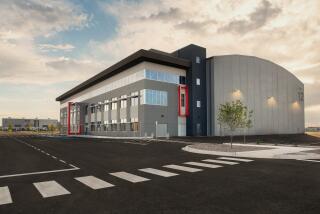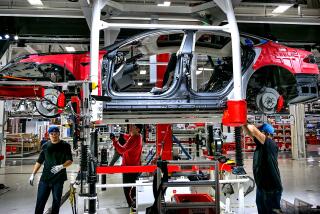Mitsubishi to Add 1,000 Jobs in Mexicali to Make TV Parts
SAN DIEGO — Joining the headlong rush of Asian television manufacturers to Baja California facilities, Mitsubishi Electronics America disclosed plans Tuesday to add nearly 1,000 jobs in the border town of Mexicali, Mexico, to make components for its line of large-screen televisions.
Mitsubishi, which sells 19% of all large-screen projection TVs sold in the United States, thus joins half a dozen other Japanese and Korean television manufacturers relocating to or expanding in Tijuana and Mexicali in recent months.
The companies are drawn by the strong Japanese yen and the weak peso, which reduces labor and other costs in Mexico for Asian-based firms, and by provisions of the North American Free Trade Agreement that offer duty-free status to televisions made in the United States, Canada and Mexico.
Over the next two years, Mitsubishi will increase its Mexicali plant space to 400,000 square feet from the current 35,000. Its employment is expected to reach 1,200 in Mexicali by March, 1997, up from 225 currently, said Jack Osborn, president of Mitsubishi Electronics America.
The expanded plant will be used to manufacture circuit boards and electronic chassis for televisions, he said. Much of that work is now done in Malaysia. Osborn declined to estimate a dollar figure for Mitsubishi’s investment in Mexicali.
Mitsubishi officials said the expansion will not threaten jobs at its Santa Ana assembly plant, where the company employs 525 people to assemble projection TVs.
Mitsubishi will be an anomaly in that it will keep final assembly of its televisions at existing plants in Santa Ana and Braselton, Ga., Osborn said. Other Asian TV manufacturers with plants in Tijuana and Mexicali now assemble televisions there, in addition to making components.
Mitsubishi’s move was prompted by the strength of the Japanese yen against the Mexican peso, Osborn said.
“We have a successful small facility in Mexicali, and we feel ready to grow to a larger stage,” he said. “We have found it cost-effective from a labor-rate point of view, and the logistics of moving components to our Santa Ana factory have run very smoothly.”
Another factor in the decision is Mitsubishi’s desire to shorten its long supply line from Southeast Asia, Osborn said. “Our circuit boards and chassis spend two months on the ocean to get here, and logistically that’s a nightmare,” he said.
More to Read
Inside the business of entertainment
The Wide Shot brings you news, analysis and insights on everything from streaming wars to production — and what it all means for the future.
You may occasionally receive promotional content from the Los Angeles Times.










